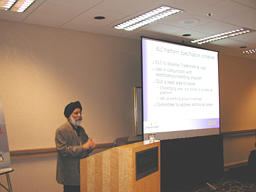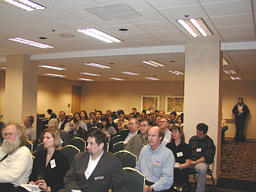ELJonline: Working toward Embedded Linux Standards: BR the ELC’s Unified Specification Plan
Jul 1, 2001 — by LinuxDevices Staff — from the LinuxDevices Archive — 2 viewsShohat and Singh explain the benefits of standardization, which will allow Linux to compete more successfully.
When more than 50 of the world's leading Linux managers and executives found their way to an organizing meeting at Chicago's Embedded Systems Conference in March 2000, they voted nearly unanimously to form the Embedded Linux Consortium as a promotional organization, specifically excluding standards activity from the initial mission.
Only 13 months later, the promotional organization's Board of Directors announced an initiative whose goal is a specification for a single unified embedded platform (read the press release at www.embedded-linux.org). The ELC's governors asked the membership to support a program of standardization that will lead to a platform specification consisting of a set of APIs for embedded Linux distributions. Designers everywhere will be able to rely upon the specification and certify their products against it using test suites. A glossary (see Sidebar) brings to life the vision and constituent parts of the specification.

Inder Singh at the Linux Consortium Meeting

ELC Board Ponders

Audience at Linux Consortium Meeting

Scott McNeil of the Free Standards Group (left) and James DeReave of the Open Group (right)
The chief benefit will be interoperability. Put another, perhaps more tantalizing way, the threat of fragmentation will no longer be much of an issue, enabling Linux to compete much more successfully for the anticipated vast supply of embedded applications.
“Will it fly?” is a key question being asked in various quarters. “Is it open?” is heard nearly as often. In the weeks since the idea was announced and debated at a well-attended (and highly supportive) meeting on the eve of San Francisco's Embedded Systems Conference 2001, progress has been made on answers and on procedures to move forward. If you are developing embedded Linux products, you'll want to track this, perhaps even participate. You do not have to be a member of the Embedded Linux Consortium to get involved.
After debating the time and effort required to change its bylaws, and the desirability of creating yet another standards organization, the Embedded Linux Consortium's Board, which includes managers and executives from Lineo, Red Hat, IBM, MontaVista and LynuxWorks, decided that the ELC would remain a promotion-centric organization and work with an existing standards organization. To this end, the ELC is actively seeking an outsource partner to handle the infrastructure needed for standardization committees and due-process procedures as well as test and conformance centers of competence. The group is counting on its ability to build a bankable brand so that it can structure marketing and promotion (under existing bylaws) around standardization in the hands of a respected partner. So far, The Open Group, Free Standards Group and EEMBC Certification Laboratories (ECL) have stepped into the outsource ring as worthy choices (see sidebar).
After a period of interactive proposal building and evaluation, the ELC's Board plans to announce its partner selection, probably by late summer. An initial draft specification may be ready around the same time, more as a list of ingredients and objectives for committee work than a design-worthy proposal.
From a historical perspective, a successful ELC Platform Specification will be the first time in more than 25 years that the embedded industry has been able to marshal resources to construct a common platform, making the proposal a possible watershed event.
Absolutely Open
Although the ELC Board is collectively the prime mover behind this effort, board members maintain their marching order represents a very broad cross section of the membership, which totals more than 120 corporations and individuals around the globe. Rather than being the brainchild of a handful, the ELC maintains, “our members asked us to do this.” And, the group intends to follow an open process involving the ELC membership as well as the broader Linux community.
By outsourcing to a respected standards organization, the ELC expects the effort to act as a magnet, attracting many companies and individuals for whom marketing and promotion, and thus membership, in the ELC is not important. Inquiries are coming in, for example, from large contract software development organizations that occupy a very early position in a supply chain that ends with household-word company names. This kind of participant wants to see the word Standards above the door first and Open second. Marketing and promotion is the business of their customer's customer, not them.
What's behind the Proposal?
Unlike the desktop side of computing, where DOS and then Windows offered platforms around which middleware and applications software took root and grew into industries, the embedded markets have never had the equivalent of a unified software platform. Embedded developers have historically built most software from scratch. Few choices of tools and middleware have been available to the embedded engineer. Most projects resemble reinvention of the wheel compared with the desktop mainstream. More than 50 choices of real-time operating systems compete in this space, but the real competitor continues to be home-brew operating systems. Make rather than buy remains popular given the special needs of many embedded applications, needs that just don't fit with shrink-wrapped legacy operating systems.
A decade ago, the POSIX (Portable Operating System Interface for UNIX) effort incorporated real-time extensions to UNIX APIs, thus defining real-time profiles pointed at an open real-time embedded platform. While these POSIX APIs have earned some appeal in the embedded community, playing a role for developers seeking portable software, POSIX has failed to acquire the widespread traction that embedded developers had hoped for. Today, POSIX earns high marks on a technical basis, but languishes as a platform. Absent the charm of the reputation-driven Open Source movement in combination with maturing Linux operating systems, POSIX has just not been able to build up enough critical mass.
What makes the ELC initiative immune to the fate of POSIX? POSIX momentum in the embedded and real-time markets was severely undercut by UNIX wars. This series of hotly competitive business moves fractured UNIX, resulting in multiple incompatible versions. This was exacerbated by the resource requirements for UNIX- and POSIX-based operating systems (e.g., the high cost of silicon for building memory management units), which tended to restrict use of the software to higher-end applications. Since large segments of the embedded space are historically cost sensitive and high volume, the dynamics of UNIX and POSIX militated against embedded success.
Enter Linux on this scene, starting only about two years ago. Even though Linux distributions are available from many vendors, all versions start with the same kernel; a high level of compatibility and interoperability between different Linux distributions is the result.
Also enter Moore's Law. Cost-sensitive and high-volume embedded applications can now afford MMU-based designs. The production economics of submicron silicon has eliminated resource constraints. In fact, falling prices and the power (function) growth of system-on-chip (SOC) devices and memory may be an ideal environment for Linux. Given increasing software complexity for embedded applications, a Linux process model tailors extremely well to high-volume embedded devices (compared with legacy flat address space real-time operating systems that function with MMU-less CPUs).
With a well-developed Linux on the stage at the same moment in history as deep sub-micron silicon, the ELC Platform Specification initiative is considered as having a high probability of success by its sponsors. The ELC membership represents strong shared interest in the success of embedded Linux. It surprises no one that the companies represented on the ELC Board of Directors include four of the leading embedded Linux suppliers and a top middleware vendor with strong commitment to the Linux platform for pervasive computing devices.
Market Effects
Down-cycle economies (as we are now experiencing) tend to amplify strategic differences among competitors. High technology is particularly notorious for marketing excesses by larger players as smaller players either succumb to the cycle or, like turtles, withdraw temporarily until conditions improve. A few very large vendors and many, many medium to small vendors populate the operating system business. As the latter group withdrawals into turtle shells, the former group engages in a campaign of fear, uncertainty and doubt (FUD), which they can afford, to convince customers that size matters. Consistent with the adage that marketing wins market share, FUD often works.
The ELC Platform Standard initiative will help counter the campaign of FUD that has been unleashed against embedded Linux by competitors who feel threatened (in spite of their size). The initiative will also forestall the threat of fragmentation among the different embedded Linux distributions while simultaneously addressing concerns of software tool vendors and embedded developers.
For Linux to realize its potential, it needs to become the leading common software platform for embedded systems, giving developers of tools, middleware and applications the assurance that a single version of their software will execute on any embedded Linux distribution that complies with the ELC Platform Specification, without requiring separate porting and validation for each distribution.
Test suites to validate compliance, along with a branded certification program are the keys to success of the initiative. Recognizing the important role of the Open Source community, as well as commercial product vendors, the test suites themselves are planned as an open-source project. The suites will be available for self-test in addition to the richer branded certification program via centers of competence (conformance labs).
Open Opportunities
Formal interface specifications — and this in essence is what the ELC Platform Specification will be — allow multiple interoperable implementations. In turn, these may be optimized to provide more choices for users, thus helping increase the overall market.
The Internet is an excellent example. The open specifications for TCP/IP, HTTP and HTML protocols and languages (plus other protocols and languages) have generated many open-source and commercial software products that have acted as rocket fuel for the growth of the Internet. The ELC Platform Specification, once complete and approved, will open similar opportunities in embedded markets. Multiple interoperable systems compliant with the specification will expand the market for embedded software products that support the platform.
Linux has been labeled a disruptive technology. Few doubt that Linux is transforming the embedded landscape. An exciting result of this ELC initiative would be a thriving ecosystem of open-source and commercial Linux-compatible software products for embedded developers. It is all about choice.
About the authors:
 Dr. Inder Singh, CEO and chairman of LynuxWorks, has been in the computer industry for over 25 years, including 12 years in embedded software, in a variety of executive and technical positions, and has served on the boards of over a dozen high-tech companies and nonprofit organizations. He is a strong advocate for embedded Linux. Dr. Singh is the chairman of the Embedded Linux Consortium.
Dr. Inder Singh, CEO and chairman of LynuxWorks, has been in the computer industry for over 25 years, including 12 years in embedded software, in a variety of executive and technical positions, and has served on the boards of over a dozen high-tech companies and nonprofit organizations. He is a strong advocate for embedded Linux. Dr. Singh is the chairman of the Embedded Linux Consortium.

Murry Shohat is a 30-year veteran of the embedded computing industry and has worked on a dual career path of technology journalist and PR strategist. His experiences span the industry's supply chain from the creation of integrated circuits via EDA to testing and measurement of finished products. Murry's academic background includes a BA in Journalism and “almost an MS” in Cybernetic Systems.
Copyright © 2001 Specialized Systems Consultants, Inc. All rights reserved. Embedded Linux Journal Online is a cooperative project of Embedded Linux Journal and LinuxDevices.com.
This article was originally published on LinuxDevices.com and has been donated to the open source community by QuinStreet Inc. Please visit LinuxToday.com for up-to-date news and articles about Linux and open source.